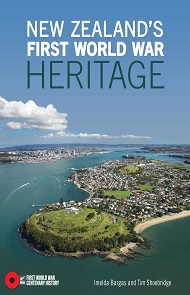New Zealand's First World War Heritage
New Zealand's First World War Heritage
Imelda Bargas and Tim Shoebridge 2015, Exisle Publishing, Auckland, 288pp ISBN 978-1-77559-129-0
Blurb:
Rediscover New Zealand’s hidden First World War history through the places where it happened. No battles were fought here, yet the First World War intruded into the daily life of every New Zealander who remained at home. This ground-breaking book provides vivid new insights into their experiences through exploring the places where they lived, worked, coped and mourned: army camps, fortifications, soldier-settler farms, town halls, wharves, convalescent homes and hospitals, cemeteries and war memorials, dairy factories and woollen mills. From Northland to Stewart Island, our landscape is signposted with thousands of poignant memorials, and behind the façades of old buildings, beneath scrub and behind farm fences lies a less visible landscape of war and hundreds of hidden stories waiting to be told: a soldier’s name carved on a remote railway station, a once bustling uniform factory in the heart of a city, a long abandoned gun battery … This unique book will be a revelation to all New Zealanders. Extensively illustrated with new and period photographs and fascinating maps, it contains original research and information that will open the eyes of every reader to places and stories in their community hidden in plain sight. The impact of the First World War on New Zealanders was immense; its legacy can be seen all around us today.
Mini Review
This is a POP page.
|
Social history with a strong link to places - both surviving buildings and memorials, and archaeological sites. A real effort has gone into the photographing of sites and buildings as well as extracting archival plans to include. The book could easily have used mainly historical pictures but it is this fresh approach that distinguishes this book, in linking places we often know to their role in our 100 year old history of the Great War.
It is not an easy book to read end to end as it perhaps inevitably jumps about a bit, as it runs by themes rather than geographically or strictly chronological, but even if only dipped into it will have readers coming back.
